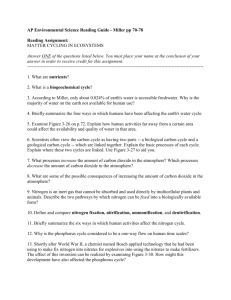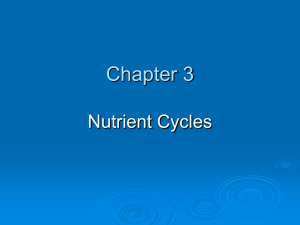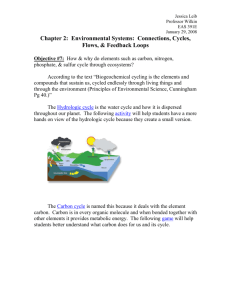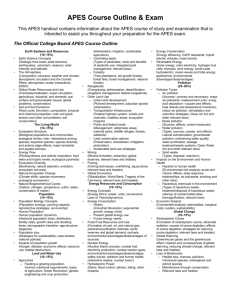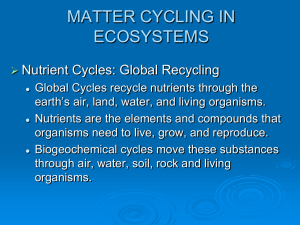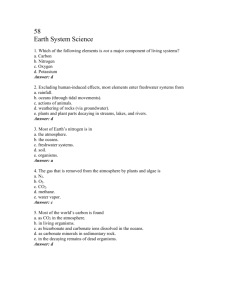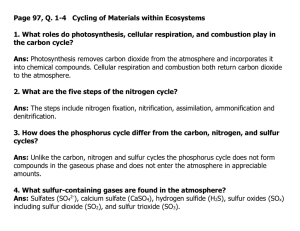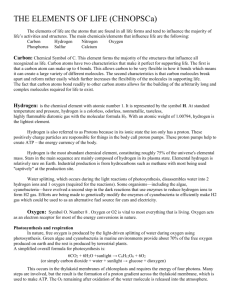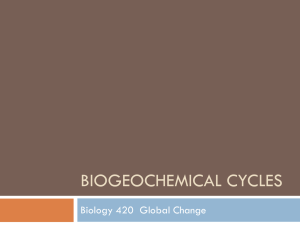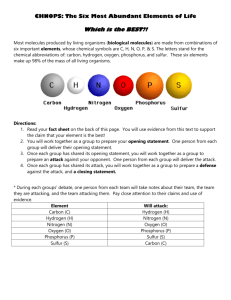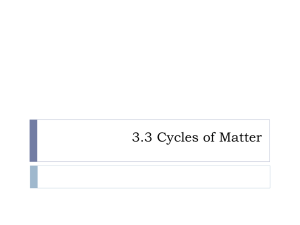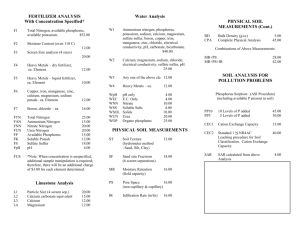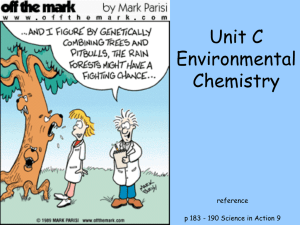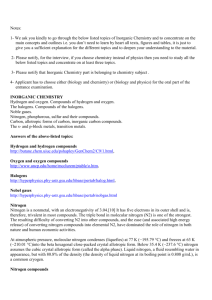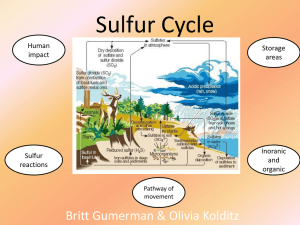ppt review for ch3
advertisement
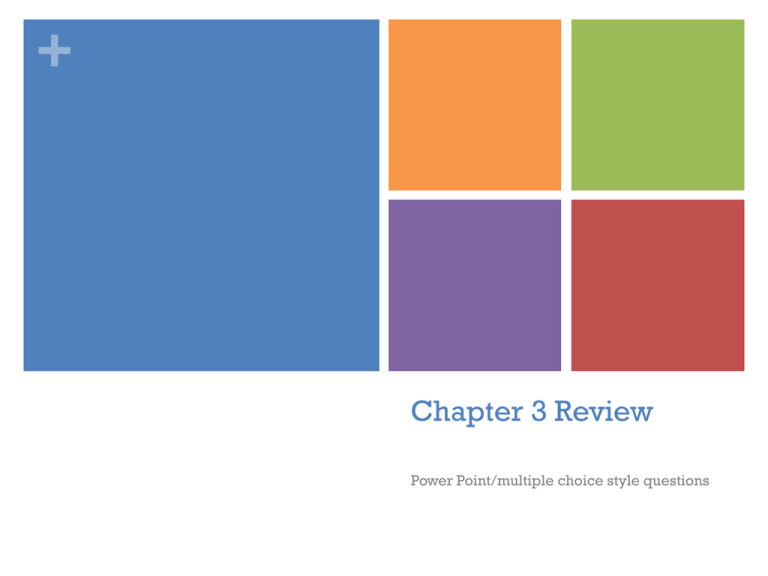
+ Chapter 3 Review Power Point/multiple choice style questions + 1 Organisms that are able to convert inorganic CO2 and H2O into glucose with energy from the sun. Producer Primary consumer Secondary consumer Tertiary consumer decomposer + 2 Fungi secreting enzyme into a fallen tree are able to cycle the nutrients from the tree back to the soil Producer Primary consumer Secondary consumer Tertiary consumer decomposer + 3 A coyote that captures an herbivorous mouse Producer Primary consumer Secondary consumer Tertiary consumer decomposer + 4 Which pair of cycles are most associated with inorganic fertilizer and sewage waste? Carbon & nitrogen Sulfur and carbon Phosphorus and nitrogen Sulfur and nitrogen Sulfur and water + 5 In which biogeochemical cycles are humans most affecting the natural greenhouse effect? Carbon & nitrogen Sulfur and carbon Phosphorus and nitrogen Sulfur and nitrogen Sulfur and water + 6 Which 2 cycles are directly related to acid deposition? Carbon & nitrogen Sulfur and carbon Phosphorus and nitrogen Sulfur and nitrogen Sulfur and water + 7 A ____ consists of all species interacting with one another and their nonliving environment. Habitat Population Community Ecosystem biosphere + 8 Which of the following is NOT considered to be an organism? A monarch butterfly Trapdoor spider Nucleus of a cell American elm orchid + 9 The following is a list of levels of organization within an ecological hierarchy. Which shows the correct sequence from narrow to broad focus? Species-ecosystem-community-ecosphere-organism-population Organism-species-population-community-ecosystem-ecosphere Ecosystem-species-ecosphere-community-population-organism Organism-population-species-community-ecosphere Ecosphere-ecosystem-community-population-species-organism + 10 The biosphere includes all of the following EXCEPT: Atmosphere Troposphere Geosphere Hydrosphere thermosphere + 11 Life on Earth depends on three interconnected factors. Which of the following are involved in sustaining life on Earth? I. Flow of high-quality energy II. Cycling of Matter or nutrients III. Gravity + 12 A group of salmon swimming in a river would be an example of a(n): Population Organism Community Ecosystem habitat + 13 Solar energy flowing through the biosphere does all of the following EXCEPT: Warms the atmosphere Evaporates water Generates winds Neutralizes carbon gas Supports plant growth + 14 Most of the solar radiation that passes through the atmosphere: Is degraded into longer wavelength infrared radiation Is converted to gamma radiation Is deflected off hard surfaces Is absorbed by the ozone Is absorbed by organisms + 15 Which of the following is NOT true regarding the Greenhouse Effect (GHE): The GHE is vital to continued life on Earth as we know it The GHE helps warm the troposphere IT is caused by the interaction of gaseous molecules that are excited by infrared radiation It is based on the potential energy of the molecules in the air It can be affected by the concentration of the atmospheric gases + 16 Which of the following is a limiting factor for a grassland biome? Number of species Species of the grass Size of the population Number of organisms Amount of precipitation + 17 Which of the following is a correctly diagramed food chain: Plankton – filter feeding clam— octopus—shark Hawk—snake—mouse—grass Scavenging vulture—oak tree— squirrel—fungi apple tree—worm—salmon— plankton Crocodile—antelope—lion--vulture + 18 The % of usable energy transferred as biomass from one trophic level to another is known as: Energy flow Gross primary productivity Ecological efficiency Biological diversity Range of tolerance + 19 All of the following are true of Net Primary Productivity (NPP) except: The rate at which an ecosystem’s producers can convert solar energy into biomass is used in determining it The chemical energy which is available in producer’s biomass for consumers is used in determining it It is higher in certain biomes receiving more solar radiation, like those found closer to the equator It is higher in certain aquatic life zones in which the limiting factor of nutrients are available It gives scientists information about the energy availability to support food webs in a given ecosystem + 20 Which cycle depends on the work of specialized bacteria for several conversions? Hydrologic Nitrogen Carbon Phosphorus sulfur + 21 Which cycle have human disrupted by burning coal and extracting metals from rock that contain large amounts of this element? Hydrologic Nitrogen Carbon Phosphorus sulfur + 22 Ecologists utilize GIS (geographic information systems)to: Develop mathematical and other models to simulate ecosystems Critique their observations Collect, overlay, and display data from various sources revealing composite effects within systems Replace field and laboratory investigations Take soil samples remotely + 23 Generalized pyramid energy flow has only a 10% efficiency, while 90% of the energy is lost to the environment as heat. This phenomenon is explain by: Law of limiting factors Law of conservation of matter The food web corollary The greenhouse effect Second law of thermodynamics + 24 A type of consumer, these organisms feed on the waste or dead bodies of other organisms: Detritivores Chemosynthesis Decomposers Producers omnivores + 25 Through this process some autotrophs are able to draw energy and produce carbohydrates n deep ocean thermal vents. Detritivores Chemosynthesis Decomposers Producers omnivores
